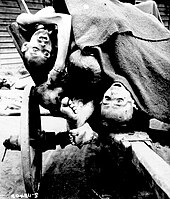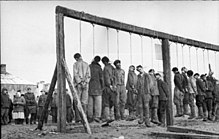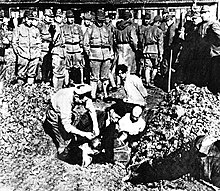Casualties and war crimes
Estimates for the total casualties of the war vary, because many deaths went unrecorded. Most suggest that some 60 million people died in the war, including about 20 million soldiers and 40 million civilians. Many civilians died because of disease, starvation, massacres, bombing and deliberate genocide. The Soviet Union lost around 27 million people during the war, almost half of all World War II deaths. One of every four Soviet citizens was killed or wounded in that war.Of the total deaths in World War II approximately 85 percent—mostly Soviet and Chinese—were on the Allied side and 15 percent on the Axis side. Many of these deaths were caused by war crimes committed by German and Japanese forces in occupied territories. An estimated 11 to 17 million civilians died as a direct or indirect result of Nazi ideological policies, including the systematic genocide of around six million Jews during The Holocaust along with a further five million Roma, Slavs, homosexuals and other ethnic and minority groups. Roughly 7.5 million civilians died in China under Japanese occupation, and the Serbs were targeted by the Axis-aligned Croatian Ustaše.
The most well-known Japanese atrocity was the Nanking Massacre, in which several hundred thousand Chinese civilians were raped and murdered. Between 3 million to more than 10 million civilians, mostly Chinese, were killed by the Japanese occupation forces. Mitsuyoshi Himeta reported 2.7 million casualties occurred during the Sankō Sakusen. General Yasuji Okamura implemented the policy in Heipei and Shantung.
The Axis forces employed limited biological and chemical weapons. The Italians used mustard gas during their conquest of Abyssinia, while the Imperial Japanese Army used a variety of such weapons during their invasion and occupation of China (see Unit 731) and in early conflicts against the Soviets. Both the Germans and Japanese tested such weapons against civilians and, in some cases, on prisoners of war.
While many of the Axis's acts were brought to trial in the world's first international tribunals, incidents caused by the Allies were not. Examples of such Allied actions include population transfer in the Soviet Union and Japanese American internment in the United States; the Operation Keelhaul, expulsion of Germans after World War II, mass rape of German women by Soviet Red Army; the Soviet Union's Katyn massacre, for which Germans faced counter-accusations of responsibility. Large numbers of famine deaths can also be partially attributed to the war, such as the Bengal famine of 1943 and the Vietnamese famine of 1944–45.
It has also been suggested by some historians the mass-bombing of civilian areas in enemy territory, including Tokyo and most notably the German cities of Dresden, Hamburg, and Cologne by Western Allies, which resulted in the destruction of more than 160 cities and killing a total of more than 600,000 German civilians be considered war crimes.
Concentration camps and slave work
Further information: The Holocaust, Consequences of German Nazism, Japanese war crimes, and Allied war crimes during World War II
The Nazis were responsible for The Holocaust, the killing of approximately six million Jews (overwhelmingly Ashkenazim), as well as two million ethnic Poles and four million others who were deemed "unworthy of life" (including the disabled and mentally ill, Soviet POWs, homosexuals, Freemasons, Jehovah's Witnesses, and Romani) as part of a programme of deliberate extermination. About 12 million, most of whom were Eastern Europeans, were employed in the German war economy as forced labourers.
Dead bodies in the Mauthausen-Gusen concentration camp after liberation, possibly political prisoners or Soviet POWs
Japanese prisoner-of-war camps, many of which were used as labour camps, also had high death rates. The International Military Tribunal for the Far East found the death rate of Western prisoners was 27.1 percent (for American POWs, 37 percent), seven times that of POWs under the Germans and Italians. While 37,583 prisoners from the UK, 28,500 from the Netherlands, and 14,473 from United States were released after the surrender of Japan, the number for the Chinese was only 56.
According to historian Zhifen Ju, at least five million Chinese civilians from northern China and Manchukuo were enslaved between 1935 and 1941 by the East Asia Development Board, or Kōain, for work in mines and war industries. After 1942, the number reached 10 million. The U.S. Library of Congress estimates that in Java, between 4 and 10 million romusha (Japanese: "manual laborers"), were forced to work by the Japanese military. About 270,000 of these Javanese laborers were sent to other Japanese-held areas in South East Asia, and only 52,000 were repatriated to Java.
On 19 February 1942, Roosevelt signed Executive Order 9066, interning thousands of Japanese, Italians, German Americans, and some emigrants from Hawaii who fled after the bombing of Pearl Harbor for the duration of the war. The U.S. and Canadian governments interned 150,000 Japanese-Americans, as well as nearly 11,000 German and Italian residents of the U.S.
In accordance with the Allied agreement made at the Yalta conference millions of POWs and civilians were used as forced labor by the Soviet Union. More than a million were also put to work in the West. In Hungary's case, Hungarians were forced to work for the Soviet Union until 1955.
Home fronts and production
In Europe, before the outbreak of the war, the Allies had significant advantages in both population and economics. In 1938, the Western Allies (United Kingdom, France, Poland and British Dominions) had a 30 percent larger population and a 30 percent higher gross domestic product than the European Axis (Germany and Italy); if colonies are included, it then gives the Allies more than a 5:1 advantage in population and nearly 2:1 advantage in GDP. In Asia at the same time, China had roughly six times the population of Japan, but only an 89 percent higher GDP; this is reduced to three times the population and only a 38 percent higher GDP if Japanese colonies are included.Though the Allies' economic and population advantages were largely mitigated during the initial rapid blitzkrieg attacks of Germany and Japan, they became the decisive factor by 1942, after the United States and Soviet Union joined the Allies, as the war largely settled into one of attrition. While the Allies' ability to out-produce the Axis is often attributed to the Allies having more access to natural resources, other factors, such as Germany and Japan's reluctance to employ women in the labour force, Allied strategic bombing, and Germany's late shift to a war economy contributed significantly. Additionally, neither Germany nor Japan planned to fight a protracted war, and were not equipped to do so. To improve their production, Germany and Japan used millions of slave labourers; Germany used about 12 million people, mostly from Eastern Europe, while Japan pressed more than 18 million people in Far East Asia.
Occupation

Soviet partisans hanged by German forces in January 1943
In the East, the much hoped for bounties of Lebensraum were never attained as fluctuating front-lines and Soviet scorched earth policies denied resources to the German invaders. Unlike in the West, the Nazi racial policy encouraged excessive brutality against what it considered to be the "inferior people" of Slavic descent; most German advances were thus followed by mass executions. Although resistance groups did form in most occupied territories, they did not significantly hamper German operations in either the East or the West until late 1943.
In Asia, Japan termed nations under its occupation as being part of the Greater East Asia Co-prosperity Sphere, essentially a Japanese hegemony which it claimed was for purposes of liberating colonised peoples. Although Japanese forces were originally welcomed as liberators from European domination in many territories, their excessive brutality turned local public opinions against them within weeks. During Japan's initial conquest it captured 4,000,000 barrels (640,000 m3) of oil (~5.5×105 tonnes) left behind by retreating Allied forces, and by 1943 was able to get production in the Dutch East Indies up to 50 million barrels (~6.8×106 t), 76 percent of its 1940 output rate.
Advances in technology and warfare
Main article: Technology during World War II
Aircraft were used for reconnaissance, as fighters, bombers and ground-support, and each role was advanced considerably. Innovation included airlift (the capability to quickly move limited high-priority supplies, equipment and personnel); and of strategic bombing (the bombing of civilian areas to destroy industry and morale). Anti-aircraft weaponry also advanced, including defences such as radar and surface-to-air artillery, such as the German 88 mm gun. The use of the jet aircraft was pioneered, and though late introduction meant it had little impact, it led to jets becoming standard in worldwide air forces.
U-995 Type VIIC at the German navy memorial at Laboe. Between 1939 and 1945, 3,500 Allied merchant ships (gross tonnage 14.5 million) were sunk at a cost of 783 German U-boats.
Land warfare changed from the static front lines of World War I to increased mobility and combined arms warfare, wherein tight coordination was sought between the various elements of military forces. The tank, which had been used predominantly for infantry support in the First World War, had evolved into the primary weapon of these forces during the Second. In the late 1930s, tank design was considerably more advanced in all areas than it had been during World War I, and advances continued throughout the war in increasing speed, armour and firepower.
At the start of the war, most commanders saw that the threat of enemy tanks should be met by tanks with superior specifications. This line of thinking was challenged by the poor performance of the relatively light early tank guns against armour, and German doctrine of avoiding tank-versus-tank combat; the latter factor, along with Germany's use of combined arms, were among the key elements of their highly successful blitzkrieg tactics across Poland and France. Many means of destroying tanks, including indirect artillery, anti-tank guns (both towed and self-propelled), mines, short-ranged infantry antitank weapons, and other tanks were utilised. Even with large-scale mechanisation of the various armies, the infantry remained the backbone of all forces, and throughout the war, most infantry equipment was similar to that utilised in World War I.
Another advance was the spread of the portable machine gun, a notable example being the German MG42, and various submachine guns which were well suited to close-quarters combat in urban and jungle settings. The assault rifle, a late war development which incorporated many of the best features of the rifle and submachine gun, became the standard postwar infantry weapon for nearly all armed forces.
Most major belligerents attempted to solve the problems of complexity and security presented by using large codebooks for cryptography with the use of ciphering machines, the most well known being the German Enigma machine. SIGINT (signals intelligence) was the countering process of decryption, with the notable examples being the British ULTRA and the Allied breaking of Japanese naval codes. Another important aspect of military intelligence was the use of deception operations, which the Allies used on several occasions to great effect, such as operations Mincemeat and Bodyguard. Other technological and engineering feats achieved during, or as a result of, the war include the world's first programmable computers (Z3, Colossus, and ENIAC), guided missiles and modern rockets, the Manhattan Project's development of nuclear weapons, the development of artificial harbours and oil pipelines under the English Channel.



